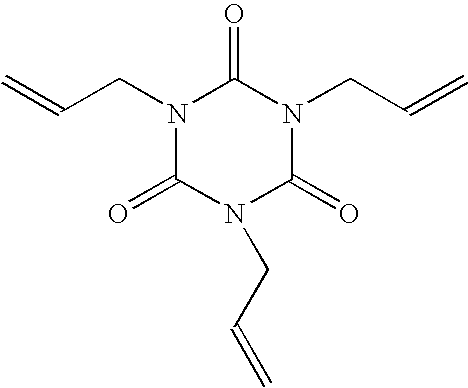Composite structure having a fluoroelastomeric anti-reflective coating with non-fluorinated cross-linking agent
a technology of fluoroelastomer and anti-reflective coating, which is applied in the field of anti-reflective coating comprising a fluoroelastomer containing a non-fluorinated cross-linking agent, can solve the problems of poor adhesion of fluoropolymers to common substrates like plastics and glass, and achieve good adhesion properties
- Summary
- Abstract
- Description
- Claims
- Application Information
AI Technical Summary
Benefits of technology
Problems solved by technology
Method used
Image
Examples
example 1
[0042] Formulation A was prepared by dissolving 4.5 g Vitone® GF-200S fluoroelastomer (DuPont), 0.45 g benzoyl peroxide (Aldrich) and 1.125 g pentaerythritol tetraacrylate (Aldrich) in 95.5 g propyl acetate, then filtering the solution through a 0.2μ Teflon® PTFE membrane filter. A strip of hard-coated triacetyl cellulose (HC-TAC) film (3.7 cm×7.5 cm) was cleaned to remove surface debris by rinsing with a stream of n-hexane followed by rinsing with a stream of iso-propyl alcohol followed by blowing dry with a stream of filtered (0.2μ) nitrogen. The cleaned strip of HC-TAC film was mounted on the surface of a glass microscope slide (5 cm×7.5 cm), with the hard-coated surface of the HC-TAC film facing outward, by fastening the edges of the film to the slide with adhesive tape. The mounted HC-TAC film was coated with formulation A by immersing it vertically in formulation A to a depth of approximately 60 mm, allowing it to remain immersed undisturbed for 30 sec, then withdrawing it ver...
example 2
[0043] The procedures of Example 1 were repeated to prepare a coated HC-TAC film with the following exceptions. Formulation A was prepared by dissolving 4.5 g Viton® GF-200S fluoroelastomer (DuPont), 0.45 g benzoyl peroxide (Aldrich) and 1.125 g triallylisocyanurate (Diak#7, DuPont) in 95.5 g propyl acetate. The coated HC-TAC film had a specular reflectance of 0.90%. The coated HC-TAC film was abraded in accord with the procedures of method 1. After abrasion the absolute value of the change in specular reflectance was 0.42%.
example 3
[0044] Formulation A was prepared by dissolving 4.5 g Viton® GF-200S fluoroelastomer (DuPont), 0.45 g benzoyl peroxide (Aldrich) and 0.45 g triallylisocyanurate (Diak #7, DuPont) in 95.5 g propyl acetate, then filtering the solution through a 0.2μ Teflon® PTFE membrane filter. A strip of hard-coated triacetyl cellulose (HC-TAC) film (3.7 cm×7.5 cm) was cleaned to remove surface debris by rinsing with a stream of n-hexane followed by rinsing with a stream of iso-propyl alcohol followed by blowing dry with a stream of filtered (0.2μ) nitrogen. The cleaned strip of HC-TAC film was mounted on the surface of a glass microscope slide (5 cm×7.5 cm), with the hard-coated surface of the HC-TAC film facing outward, by fastening the edges of the film to the slide with adhesive tape. The mounted HC-TAC film was surface-treated by application of RIE plasma in accord with the procedures of method 2. The so-treated mounted HC-TAC film was coated with formulation A by immersing it vertically in for...
PUM
| Property | Measurement | Unit |
|---|---|---|
| specular reflectance | aaaaa | aaaaa |
| total reflectance | aaaaa | aaaaa |
| reflectance | aaaaa | aaaaa |
Abstract
Description
Claims
Application Information
 Login to View More
Login to View More - R&D
- Intellectual Property
- Life Sciences
- Materials
- Tech Scout
- Unparalleled Data Quality
- Higher Quality Content
- 60% Fewer Hallucinations
Browse by: Latest US Patents, China's latest patents, Technical Efficacy Thesaurus, Application Domain, Technology Topic, Popular Technical Reports.
© 2025 PatSnap. All rights reserved.Legal|Privacy policy|Modern Slavery Act Transparency Statement|Sitemap|About US| Contact US: help@patsnap.com



